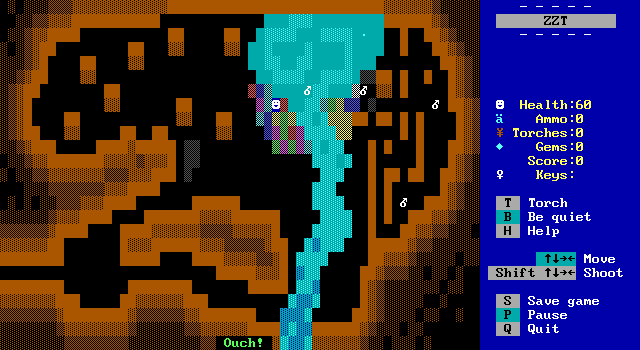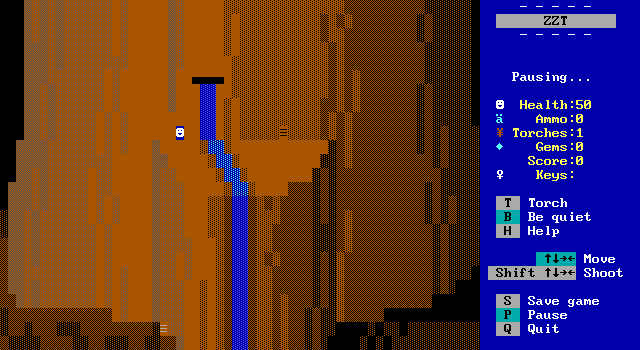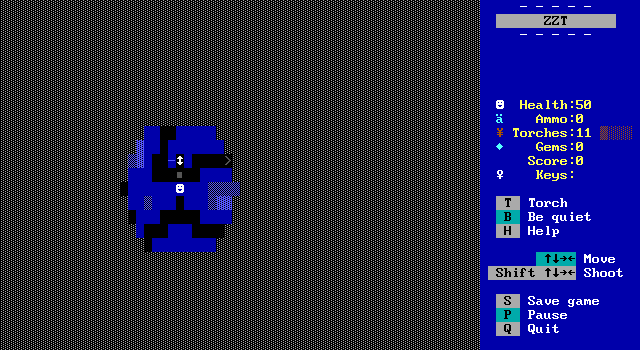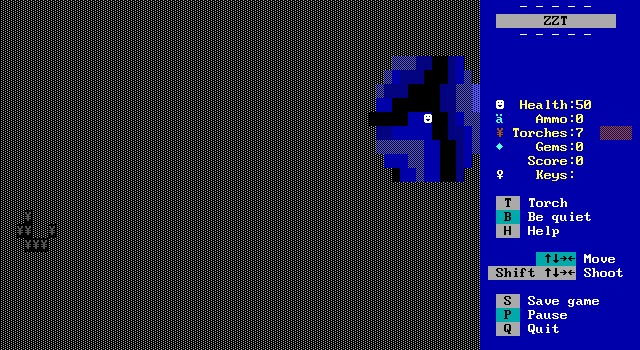
The player has to figure out what they're supposed to do here, which is bomb the fountains that feed the spring. The thing is though, that you have to bomb them three times.
The solid looking walls of the spring are actually fake, so to access the other half of the screen two of the bubbles have to be destroyed

This turns out to be incredibly difficult! I definitely struggled the most with this board, and spent the most time on it.
With the earlier slider puzzle I mentioned preferring a puzzle be too easy than too hard, and I'm glad to say that as tough as it was to get through it, I had fun. It felt like I accomplished something when I finally beat it.
It's not without flaws though. Most notably is that bombs won't explode over fake walls so it can be difficult to get a grasp on whether or not a fountain bubble is in its radius.
Myth does give the puzzle visual cues. Each fountain does change to a different animation with every hit, but it's very difficult to gauge how inaccurate you were if you miss.With a third of an explosion just not displayed here it's hard to tell if pushing the bomb another tile inward would hit something that wasn't.

The challenge isn't so much about positioning the bombs, as you obviously want to get them as close to the fountains as possible, but managing to find a route to do so. The bombs are in an area with a bunch of small walls and breakables. Touching a bomb begins its countdown immediately. There's a lot of experimenting to figure out how far you can push a bomb and in what order you want to ignite them. Careful consideration needs to be taken on if it's worth using a bomb to clear breakable walls and open up the path for future bombs or if it should just be pushed into the spring.
There is a bit of a trick where you can use a lit bomb to push non-lit ones, but the actual maneuvers make this rather difficult to exploit.
(Honestly, if you asked me to solve this puzzle again right now I'd have no idea where to begin.)

Besides covering up explosions, fake walls make things even more of a pain in that the player can push a bomb mid-explosion onto a fake wall since it won't be covered by a breakable. This basically soft-locks the puzzle as the explosion clearing routine will begin from the bomb's new location leaving residue like shown here.
And because the timing is so tight, you want to push the bombs onto fake walls before they explode, so it's very easy to keep accidentally doing this.

Jumping past nearly 30 screenshots of me setting off bombs and hoping I'm doing it right, I eventually make it to the second half. It definitely helps to just not worry about your health. This is the only time the player can get hurt in Winter, but I didn't know that at the time.

When you finally make it across, there's still one more fountain to deal with, but the three bombs have very obvious paths making the second half of this puzzle a bit of a dud. (:rimshot:)

And with the last fountain destroyed, the spring rapidly dries up.
I had no idea why this was important and didn't know where to go next.

This meant going back to the previous cave and turning on the lights since I had run entirely out of torches. This lack of lighting is one of Winter's few flaws. I tried touching all the walls in that room with the objects to no avail, only to realize that the outer walls there were actually brown-on-brown transporters.
I'm not sure if that was supposed to count as a puzzle or just a moment of clunky design. Transporters to do 3-D space like this isn't that uncommon of a technique, but usually they're either not invisible, or something is done to make it clear that they're there. Had the path through the caves ran vertically, with transporters moving the player horizontally instead, they'd be forced to find the solution right away as there'd be nothing in the cavern otherwise other than a dead end.

And this is where the spring runs. As soon as the player steps off the passage and unpauses the game, the objects will detect the spring being shut off and the water will disappear.
I really love the perspective here and how 3-D it all feels.

Crossing the now dry-waterfall leads to another cave as the player continues their descent. There was at least one last torch to pick up in the first cave on my way here and it's enough to get through this cave since it's completely linear.

In the center of the cave by some more torches there's this strange symbol surrounded by a white border. There's no way to interact, but it's very clear that it's going to be important. Keep it in the back of your mind.

And with that last cavern, the player reaches the bottom of the mesa.

The base of which has a final puzzle for the area. Here there's a large lake with several gaps, five switches, and a question mark.

Touching each switch spawns a boulder in its corresponding column with the following colors. Hitting the question mark parses the boulders and of course does nothing at first since the puzzle needs to actually be solved.

Hitting the switches multiple times will change its boulder's color. There are five colors to cycle through.
This puzzle is loosely based on Mastermind, where the player needs to deduce the correct combination. However the approach to the puzzle is less about figuring out the combination and more about figuring out how to interpret the feedback given from incorrect input.

Messing around with the inputs a bit, you'll begin to notice that the question mark is clearly checking each boulder one by one. If the color is correct, a tone plays, and if not there's silence. It can be difficult to tell how long the pauses between each boulder run, so what I wound up doing was getting the first color correct to get an immediate beep, followed by silence from all the others being wrong. Then trying to get the final column correct so it's easier to tell how long the response is supposed to be.

Towards the very end I actually noticed the pattern here going from cold to warm colors. This fade is especially common in older ZZT worlds (often pre-STK). I'm not su- Oh my god I'm in the middle of writing this sentence about how I wasn't sure if there was a hint given and just now remembered the triangles on the peak of the mesa which sure enough, correspond in color to the puzzle solution.
Ffff.

Ok. Well, you know what, there's a way to speed up blind guessing and it's valid and I'm good at solving puzzles actually.

Depositing the purple key made for a good time to write down all the combinations of symbols for the still incomplete puzzle in the western portion of the castle.

Unfortunately, I ran into a bug here. While I could enter the first two combinations and get a sound to play when they were each finished, the last combination just would not work. I'm unsure if this is a coding error where one of my incorrect combinations broke an object, or if there's just a mistake where the combination expected doesn't actually match the one given in the bedrooms.
This sort of puzzle is one that's going to have delicate coding with lots of zapping and restoring of labels, and it needs to track three different passwords, resetting things on a mistake appropriately. Given the quality of the game's programming otherwise, I'm honestly way more inclined to believe that I broke it rather than the given password being wrong.

I wasn't happy with what happened, and had cheat my way past, vowing to return later in a new game and figure out what had happened.
And when I did go back I was still left unsure. Starting a new game I discovered that the door opens as soon as what I'm considered password number three is entered making the other two unnecessary. (I counted in the order you'd reach each clue, so right, top, and then left.)
If you enter them in the order 2-1-3 then the puzzle works, likely as intended, but if you go 1-2-3 the third password will never get processed and you'll be stuck. I'm chalking this up to coding errors after all.

Visually, the final area I ventured to in Winter is the least interesting. It's not bad looking, and as far as ZZT caves go, still manages to be one of the better looking ones, but compared to the colorful forest or the really nice sense of height with the mesa, it's a bit lacking.

The entrance provides a decent amount of torches. I might have had better luck in the mesa's caverns had I started with this path, but I think relying on leftovers here would just mean keeping the torch count tight here, and either way, you're not going to be aware that torches will be needed on another path beforehand.

The caves bring back another classic ZZT puzzle with a transporter maze. These are generally at their most fun when you can just zip all around the board and hear that satisfying transporter noise constantly.

Myth complicates thing with several gates that block off certain paths.
Since the room is dark, there isn't really any strategy to the maze beyond exploring paths not yet explored. It might have been better to do something with a lit room and a time limit on it to encourage taking in the whole layout and finding an optimal path to make it through without being harmed from time expiring.


There's also the strange choice with these gates that they rely on an object which eats away at what's pushed into it, destroying the gate rather than opening it. However, the hidden objects don't destroy the entire gate, and place an invisible wall leaving the last piece sticking out.
Admittedly, this is used to add more complexity to the puzzle here as not only does the gate need to be opened, but also the last piece must be pushed out of the way. I just don't think it's communicated that well.

It's still pretty basic until this particular dead end is reached. There's a number than can be touched to cycle it between 1, 2, and 3. My first instinct was to set it to "2" and see what changed.

Unsurprisingly, the number is tied to three more numbered gates, but oddly they don't open with the matching number, instead opening on the matching number plus 1. This feels like it might be a programming issue.
In reality I found this 2-gate before finding the switch so I was really expecting setting the value to "2" to open it.

So I turned on the lights to make sure I wasn't missing anything. Here you can see the switch set to 3 with 2-gate opened (there's a fake wall which isn't entirely obvious when the lights are off and you don't actually see the objects move as the gates open and close).

As usual, once the lights are on I can't bring myself to care enough to turn them off again. There was this location in the top right still unexplored with a different switch.

The switch erases the pile of boulders on the left exit.

From the white switch room, there's another transporter that lets the player move to the connecting southern board, which actually continues the maze.
There's nothing new here, no gates, no switches, just a few more transporters. I don't think this board adds enough to the puzzle to really be worth having.

Its sole purpose is to provide a path to this cool looking room in which some kind of oversized computer whirs away by some sort of slimy green river. Though with one last gate, the use of a second dark maze does create a good tease since the player now needs to find the other path to this room to push the boulder out of the way.
Myth's efforts of creating anticipation worked. I was really curious what this was going to be and found some fresh motivation to getting through the maze. Getting to the other side means taking the west exit from the first board, done by playing with the numbered gates a bit to create a path.

Okay, so the computer thing was a good way to capture the player's interest, but then myth swerves and gives you this board on your way to it. Ten objects in giant tubes all hooked up together with no idea what purpose they serve.
I only wish this was some weird puzzle, but for now it's just a piece of unusual art.
The wiring of course is connected to that strange machine, and when entered the board from this side with that boulder pushed into place, it's time to step inside the machine.

As is often the case, it's hard to say what this actually is, but it's definitely cool looking.
The lower left corner flickers between reds and yellows, and within the machine there's a large device with a bunch of wiring and nodes. This one is the next puzzle.

The red portions of the circuitry can be touched to toggle the connection. The layout isn't important, this is just a very well stylized puzzle.
Playing with the wires causes a very satisfying effect of the numbers increasing or decreasing to new values further enhanced by the sound effects. Each piece has a different effect on the numbers and the goal isn't made apparent, but sensible guesses may include making the numbers match, making one as high as possible and the other as low as possible, or the actual solution, getting them specifically to both read zero.

It's not an easy puzzle, and you can study the solution in the screenshot here. You definitely want to take notes with this one, coming up with a system to identify which piece is which and then the change that happens to the numbers when going from on to off as well as off to on. Then you need to start finding a series of numbers that will sum to zero
It's made tougher by the fact that any wire can have any effect on the numbers. It's not a simple as disconnecting making them decrease, and connecting them making them increase.
Plus the layout is purposely unfriendly. Though the rat's nest of wires is all fluff, it makes for longer travel time to go from one to another which subtly makes you want to stick to the left or right halves to have quick access to three pieces instead of constantly navigating the perimeter of wiring.

I made the mistake of just having all the wires connected and only writing down what happens when you disconnect them, making the mental math a bit tougher to track in my head. (At least I think.) I was about to start over and make sure to actually note the changes on connection/disconnection instead of flipping signs in my head when I accidentally managed to get a zero-zero readout.
Once it's complete, the system shuts down and a laser wall deactivates, letting the player hit a switch and turn back.
The tubes drain of liquid and open, releasing their occupants who unfortunately don't all make it out okay. The strange beings are undaunted and open up a portal back to the castle, leaving the last key behind.

With the final purple key, all that's left is to explore what's beyond the bedrooms.

But of course, it's never over just because all the keys have been collected. Myth has one last puzzle to challenge you into comprehending.

A four by four grid of rectangles. Touching them toggles them between white and blue.
The last puzzle is one of memory. Myth had a goal to make everything have a purpose in Winter, and there's one thing that hasn't come up yet.
Even cooler was going through screenshots for this article and realizing the solution also appears more discretely back in the forest as well.

That strange symbol from the mesa just so happens to fit the grid here. Lighting up the proper cells and the door opens to a path to a platform with one final button bathed in light.
Myth does a really nice job with these last two boards, drawing them out with these long (but thankfully not too twisty) paths. It makes things feel like they're building up compared to if the player had simply started next to the blue walls or this platform.

One final board to turn to nothingness, and one passage out of the palace of the mind.

Of course, this is all just a daydream, and the protagonist could have woken up and paid attention in class at any moment.
There's this brief glimpse of something sinister, hinted at earlier in the text file, but for all the strange occupants of the palace and its other locales, nobody ever said a word. Some mysteries don't get to be solved.

And that's Winter. Not even a game over. If the player wants to wake up, they'll have to quit themselves.
I love the inclusion of music listened to, something rarely seen outside of contests since the development could take significantly longer.
Final Thoughts
While most ZZT games of the era feel like the editor was opened and whatever came to the author's mind got included, Winter is a refreshingly modern game that you'd hardly guess was over twenty years old now. Myth clearly developed the game with goals in mind, and I think she achieved them. This game has a very powerful atmosphere and greatly earned its strong reputation as a lovingly crafted puzzle game.
Myth took on the self-imposed challenge of a game free of text did an excellent job surpassing that challenge with a combination of memorable locations, unique puzzles, and an eye for good design. It almost feels like a ZZT take on Myst. From technicolor trees to technological machines myth conjures up surreal scenery throughout Winter. She does so in a way that makes things more than just eye-catching set pieces but oddities whose functions must be figured out by putting the pieces together yourself.
Playing it today, I was pleasantly surprised at the effort put into the game. The level of polish and care into making objects become spectacle, getting shows of light and sound as you input passwords or animations of digits recalculating. Whether dropping the player from the sky to a mesa peak or watching the glass tubes drain and release their occupants, myth absolutely keeps the player in the head-space of being flung throughout an idle mind, always stopping to admire the details and being rewarded for doing so.
For all the praise I want to give Winter, there were the unfortunate issues of the mesa not providing enough torches for all but the speediest players, and kind-of-sort-of functioning puzzle to access the caves. The latter in particular is a rather noticeable stain on an otherwise very high quality game. Winter is easily one of the better games I've played for this series, and can respectably keep up with modern puzzlers like Benco's Ana or Rabbitboots's Faus Amis. If you have any interest in ZZT puzzle games, myth's Winter is simply a must play.



Now we're puzzling! An underground spring runs through this board, some objects appear to bubble up top, and there are a whole bunch of bombs.